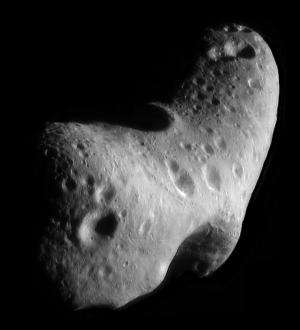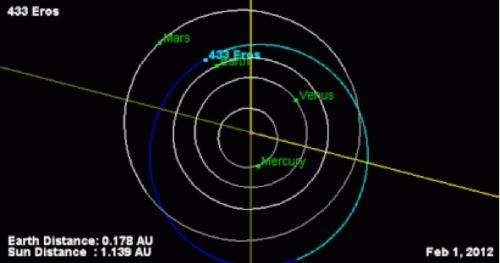Asteroid to make closest approach since 1975

On Tuesday, January 31, asteroid 433 Eros will come closer to Earth than it has in 37 years, traveling across the night sky in the constellations Leo, Sextans and Hydra. At its closest pass of 16.6 million miles (26.7 million km) the relatively bright 21-mile (34-km) -wide asteroid will be visible with even modest backyard telescopes, approaching magnitude 8, possibly even 7. It hasn’t come this close since 1975, and won’t do so again until 2056!
433 Eros is an S-type asteroid, signifying a composition of magnesium silicates and iron. S-types make up about 17 percent of known asteroids and are some of the brightest, with albedos (reflectivity) in the range of 0.10 – 0.22. S-type asteroids are most common in the inner asteroid belt and, as in the case of Eros, can even pass within the orbit of Mars.
Occasionally Eros’ orbit brings it close enough to Earth that it can be spotted with amateur telescopes. 2012 will be one of those times.
Eros was discovered on August 13, 1898, by astronomers Carl Gustav Witt in Berlin and Auguste Charlois in Nice. When Eros’ orbit was calculated it was seen to be an elongated oval that brought it within the orbit of Mars. This allowed for good observations of the bright asteroid, and eventually led to more accurate estimates of the distance from Earth to the Sun.

In February 2000 NASA’s NEAR Shoemaker spacecraft approached Eros, established orbit and made a soft landing on its surface, the first mission ever to do so. While in orbit NEAR took over 160,000 images of Eros’ surface, identifying over 100,000 craters, a million house-sized boulders (give or take a few) and helped researchers conclude that the cashew-shaped Eros is a solid object rather than a “rubble pile” held together by gravity.
View NEAR images of Eros’ surface.
Studying pristine objects like Eros gives insight into the earliest days of our solar system, and also allows scientists to better understand asteroid compositions… which is invaluable information when deciding how best to avoid any potential future impacts.
Although Eros will be making a “close” approach to Earth on Jan. 31/Feb. 1, there is no danger of a collision. It will still remain at a very respectable distance of about 16.6 million miles (26.7 million km), or 0.178 AU. This is over 80 times the distance of the much smaller 2005 YU55, which safely passed within a lunar orbit radius on November 8, 2011.
If you do want to try viewing 433 Eros as it passes, you can find a diagram charting its path from Sky and Telescope here. According to the Sydney Observatory’s website “the coordinates on 31 January (from the BAA 2012 Handbook) are 10 hours 33 minutes 19.0 seconds RA and -4° 48’ 23” declination. On 10 February the RA is 10 hours 20 minutes 27.6 seconds and the declination is -14° 38’ 49 seconds.”
Also there’s an updated chart on Heavens Above showing Eros’ current position.
Eros should remain visible up until Feb. 10.
Source: Universe Today


















